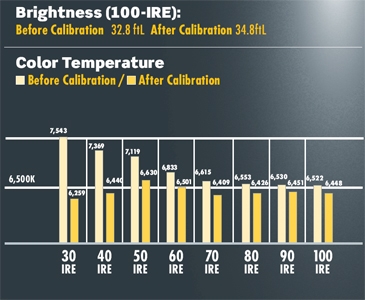Hitachi Ultravision L46S603 46-inch LCD HDTV Page 3

TEST BENCH
Brightness (100 IRE): Before Calibration: 32.8 ftL; After Calibration: 34.8 ftL
Primary Color Point Accuracy vs. SMPTE HD Standard| Color | Target X | Measured X | Target Y | Measured Y |
| Red | 0.63 | 0.64 | 0.34 | 0.33 |
| Green | 0.31 | 0.28 | 0.60 | 0.53 |
| Blue | 0.155 | 0.164 | 0.07 | 0.07 |
Out of the box, grayscale tracking with the L46S603's Pro-Night mode/Standard color temperature settings selected proved accurate in the brightest windows but grew increasingly blue as the picture got darker, resulting in a reading that was +1,043 K of the 6,500-K standard at 30 IRE. Using the white balance controls, I was able to bring tracking back to within ±130K from 40 to 100 IRE and -241K at 30 IRE. Color primaries were close to the SMPTE HDTV spec for red but slightly undersaturated for blue and green. After adjustments, the color decoder measured a perfect 0% error for all three primaries.
Overscan measured 0% in the Full "pixel-for-pixel" mode, 3% in the 16:9 mode, and 3% with HD content when the Aspect control was set to Auto. The Hitachi fully resolved 1080i/p and 720p HD test patterns via its HDMI or component-video inputs, though the component video input was slightly softer than HDMI with 1080isignals. Full-frame gray test patterns showed good picture uniformity across the screen, with no visible backlight striations or hotspotting. The matte screen surface was very effective at rejecting glare even with my room's overhead lights on. The viewing angle was acceptable but not as wide as on some LCDs I've seen; I could detect very subtle color shifting beyond 35° off the center axis from a distance of 8 feet, though picture quality remained acceptable well beyond that point.
The Hitachi had trouble with the Film Resolution Loss test on the Silicon Optix HQV Blu-ray Disc irrespective of its Auto Movie or Reel120 Motion menu settings. With Auto Movie on or off, the test pattern's fine-resolution box remained unstable, and with Reel120 Motion turned on, there was an obvious halving of resolution. But movie images always looked crisp, and I never saw evidence of any problems with any other real program material. The set aced every other test on either the Blu-ray or DVD versions of the Silicon Optix disc, and it showed exceptionally good results on the jaggies tests for checking deinterlacing and upconversion performance. The noise tests on the DVD version revealed that the Hitachi does not exaggerate random video noise the way some other HDTVs do. And with its Noise Reduction menu option set to High, the TV was very effective at cleaning signals up with only a barely perceptible sacrifice of image detail.
Hitachi's Reel120 Motion 120-Hz processing mode did an excellent job smoothing the horizontal motion of camera pans and improving the clarity of fast-moving objects, though I saw no difference between its Low, Mid, and High settings. Like similar features on other sets, it tended to make film-sourced programs look like video, and though Hitachi's realization of this feature is less offensive than some others I've seen, I left it turned off for movies and only flipped it on for watching fast-action sports.
-- Rob Sabin













































